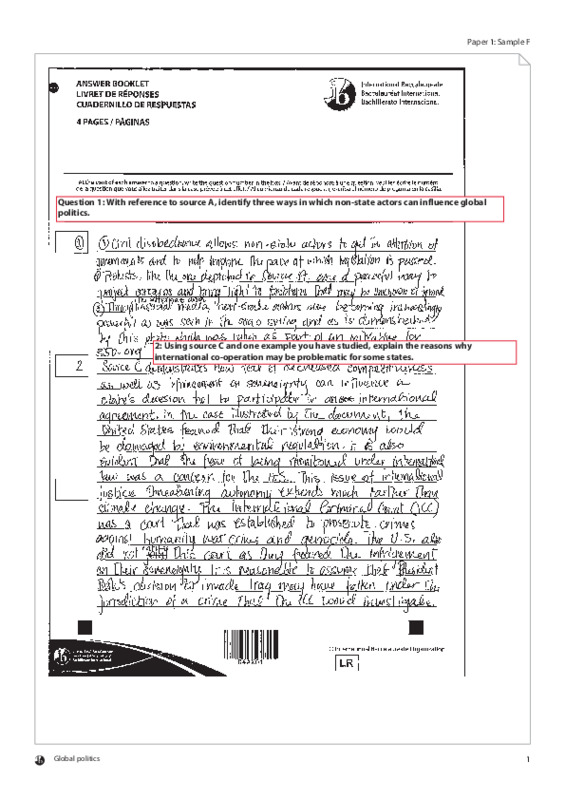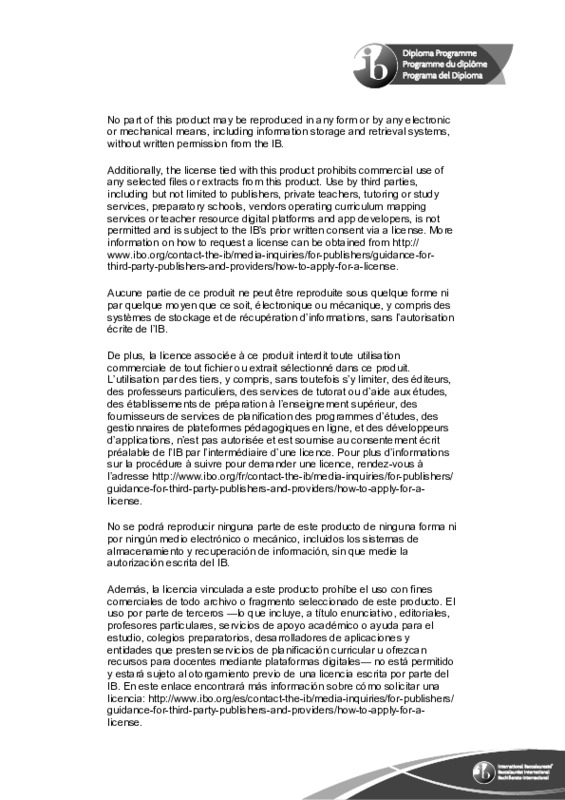Assessed Student Work (Paper 2 and Paper 1)
Marked Paper 1 on Power
Material for practice essays: May 2019 Global Politics Paper 2
Marked Essays : all these essays scored between 15 and 22
 P2_sample_D_e.pdf
P2_sample_D_e.pdf-
Question 8: Discuss the view that peace is more than simply the absence of war.
[Unit of study: Peace and conflict]
A very good response to the question. The candidate clearly distinguishes between the positive and negative dimensions of peace and ably supports this distinction with the inclusion of relevant real-world examples. However, while much was made of situations in which a negative peace was clearly not peace, per se, the candidate did not provide the same degree of analysis (or attention) to some of the processes required for a positive peace to prevail. Counterclaims were considered but were not really explored (or evaluated) in enough detail. Still, there was clearly enough here to warrant a mark in the mid-range of the 16–20 markband.
Overall comment
A strong series of responses that just lack the consistency, critical thought and depth that is expected of the very best responses. Still, this was an impressive performance overall.  Paper 2 essays ( F)
Paper 2 essays ( F)-
Question 8: Discuss the view that peace is more than simply the absence of war.
[Unit of study: Peace and conflict]
A very solid response to the question, one that displays a firm grasp of the key global politics concepts. However, there is something of a disconnect between some terms and examples and the question (and/or main points) being advanced—likely due to this being the final essay and the candidate having insufficient time remaining. All the main requirements of a response are included, but the lack of fluency in terms of connecting all the disparate parts together (along with some terminological gaps) means that this answer as a whole cannot score in the top markband.
Overall comment
A strong series of responses that just lack the consistency and attention to detail that is expected of the very best responses. Still, this was an impressive performance overall.  P2 sample essays.pdf
P2 sample essays.pdf
Exminer´s comments
Examiner comments
MARKS 15/ 25
Something of a mixed response. In places, the candidate has done a good job of outlining how economically powerful states can, in fact, manipulate institutions of global governance, such as the UN. In addition, he or she neatly recognizes how such power may also be constrained by the issue at hand. With this in mind, it is fair to say that the candidate has understood the demands of the question, and has displayed a more than satisfactory grasp of some key concepts of the global politics course. However, there are also numerous instances where the candidate becomes confused and the discussion descends into description, with some irrelevant and even flawed facts advanced. A counterclaim is attempted but is rather disingenuous in its approach. With all of this considered, a mark in the upper range of the 11–15 markband is appropriate.
MARKS 18/25
A relatively strong, if slightly disjointed, response to the question. The candidate does an admirable job of a decent, if somewhat unevenly structured, response to the question. The candidate ably outlines different reasons why human rights might be unenforceable with reference to a suitable range of valid, contemporary real-world examples. Generally this is done well, although some of the examples could have easily been developed further. The candidate then presents at least one compelling reason as to why human rights might still be of use to vulnerable populations even if it is the case that such rights are generally unenforced/unenforceable. While a straightforward counterclaim is not necessarily present the candidate has certainly done enough to explore alternative views on the question to fulfill this requirement. As such, the 16–20 markband is clearly warranted, but there is not enough evaluation or critical analysis to push this paper into the top markband. As noted above, the structure of the essay is quite problematic and this limited the upper range of the overall mark. Still, this remains a more than capable essay.
Question 8: Discuss the view that peace is more than simply the absence of war.
MARKS 22/25
Overall, an excellent response to the question at hand, although the candidate did seem to lose his or her way towards the end of the paper (perhaps striving to do too much as time was running out?). The conceptualization of the key ideas (positive and negative peace) and the different views surrounding each was adept, and real-world examples were generally used to good effect also. The counterclaims offered were excellent and it is clear that the candidate not only explored but also sought to evaluate these. Certainly, some of the examples needed to be developed a little further and there was one line of argument (the case of the EU towards the end of the piece) that seemed strangely out of place. In addition, the paper was a little disjointed in terms of its flow and the implication of the question could have been explored in a little more depth/detail. Regardless, this was a very fine essay.
An interesting case as the candidate built pace and depth throughout the exam (it is more common to see a drop in these elements with the final essay). This is also a good example of a series of responses in which the candidate does not employ a “traditional” counterclaim but, rather, offers different views on the question under consideration.

